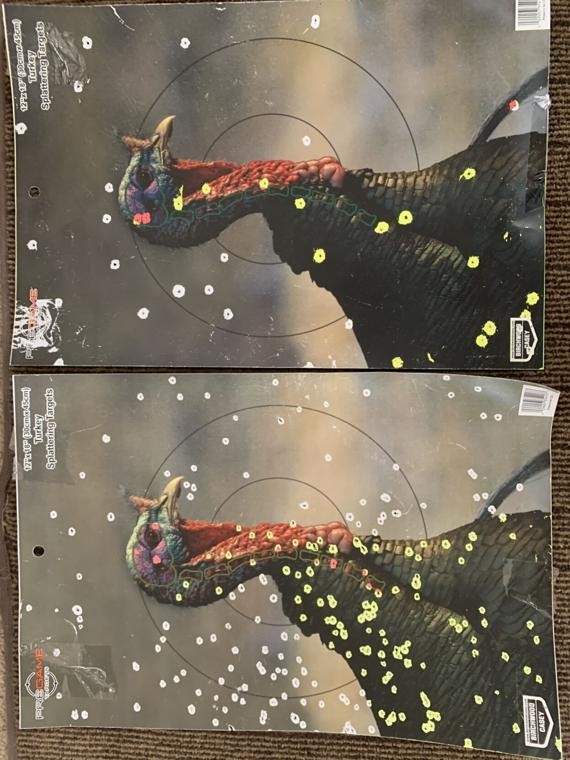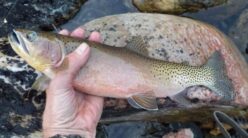A lot of turkey hunters think that the whole key in being successful is to learn how to call superbly and that’s all they focus on. In my turkey seminars, I teach that calling is about 20 percent of the puzzle. You have to also learn strategy, camo, decoys and many other details if you want to be successful. Calling is actually only a small part of ensuring that you have a successful turkey hunt. There are many champion callers that can call a whole lot better than me but they aren’t good hunters.
So with the above said, let’s discuss an often-forgotten piece of the puzzle — patterning your shotgun. On most of your shot gunning you can switch out the choke and use one shotgun for multiple hunts but if at all possible, for turkey hunting it is nice if you can designate one shotgun for turkeys. Here’s why. To shoot out to 40, 50 or even 60 yards, you’re going to need a sight or a scope because using the beads on top of the ventilated rib just doesn’t work. If you have to mount, unmount a sight or scope every spring on your multi-purpose shotgun it will be a pain.
This year I got a Mossberg 930 and mounted a Vortex SPARC AR Red Dot scope on it. If you can’t afford to designate one shotgun for turkeys, don’t panic. But for sure use a good turkey choke like a TruLock .650 or .660 choke so that you can get a tight pattern. Even my youngest daughter looked at a target I shot and said, “Daddy, you don’t want that many BBs in him do you?” It put 132 BBs on the target.
After you get a good choke, test three or four different loads because they vary in how they perform. Turkeys are tough birds so you want to make sure you use the best shells. The bad deal is, the good turkey loads are expensive. They run from $1 to $5 per shell so you don’t want to waste too many on the range but still, if you go to all the time, trouble and expense of going hunting it’s a small investment to do so. From what I’ve tested, HEVI-Shot out performs everyone else.
To make the choice even more complicated, manufacturers offer different sizes of shot and HEVI-Shot even offers a blend of 5, 6 and 7 shot in one load. The theory is, the 5s are heavier and even though lighter, the 7s provide for a tighter pattern. You’ll have to decide what size shot you prefer.
If you test a lot of different manufacturers then you ought to buy a Caldwell Lead Sled. If you don’t, after shooting a few of the 3-inch or 3 ½-inch shells you’ll be flinching. (OK, I hate to be a wimp but the 3 ½-inch shells KICK BIG TIME.) Also to reduce flinching, wear double ear protection. I wear foam earplugs and earmuffs.
To pattern your shotgun, aim 5-7 inches below the head. That way the bulk of the pattern hits from the heart to the head. If you shoot at the head, half of the BB’s whiz harmlessly overhead. I like to use Birchwood Casey Shoot N-C targets. They make it easy to count how many BBs are in the kill zone. To count how many BBs hit in the kill zone I lay a piece of paper over the target and count holes as I slowly slide it down. Shoot and then count how many BBs hit in the head/neck area. I’m sure there is a socially accepted number you want to obtain but I don’t know what that is.
Do you have to buy store bought targets? If you’re a kid on a paper route budget — no! you can get a large piece of cardboard and draw a turkey on it. Color the head red so it’s visible at 40 yards. After you’ve decided which shell to use, shoot at 20, 30, 40 and 50 yards. That way you’ll know how effective you’ll be at each range. If you have a really tight choke it’s easy to miss if one is really close.
Some of the loads will have up to 2 ¼ ounces of shot so they kick. So it doesn’t scare off young hunters and women, have them shoot a 3-inch mag in a 20 gauge. Put a recoil pad on their gun.
Tom Claycomb lives in Idaho and has outdoors columns in newspapers in Alaska, Idaho, Utah, Nevada, Colorado and Louisiana. He also writes for various outdoors magazines and teaches outdoors seminars at stores like Cabela’s, Sportsman’s Warehouse and Bass Pro Shop.



